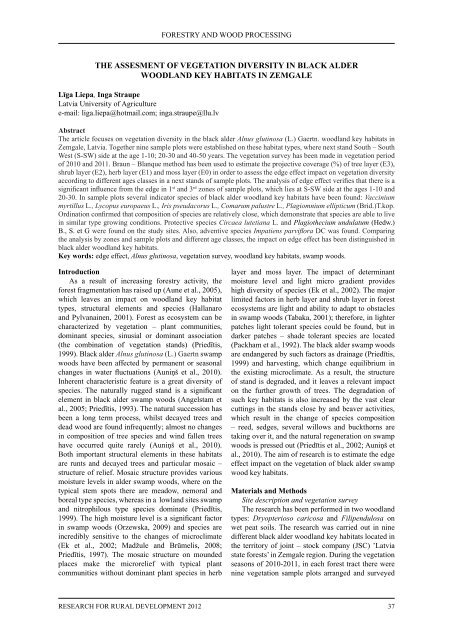RESEARCH FOR
RESEARCH FOR
RESEARCH FOR
You also want an ePaper? Increase the reach of your titles
YUMPU automatically turns print PDFs into web optimized ePapers that Google loves.
tHe assesment of vegetatIon dIversIty In blacK alder<br />
Woodland Key HabItats In Zemgale<br />
Līga Liepa, Inga straupe<br />
Latvia University of Agriculture<br />
e-mail: liga.liepa@hotmail.com; inga.straupe@llu.lv<br />
abstract<br />
The article focuses on vegetation diversity in the black alder Alnus glutinosa (L.) Gaertn. woodland key habitats in<br />
Zemgale, Latvia. Together nine sample plots were established on these habitat types, where next stand South – South<br />
West (S-SW) side at the age 1-10; 20-30 and 40-50 years. The vegetation survey has been made in vegetation period<br />
of 2010 and 2011. Braun – Blanque method has been used to estimate the projective coverage (%) of tree layer (E3),<br />
shrub layer (E2), herb layer (E1) and moss layer (E0) in order to assess the edge effect impact on vegetation diversity<br />
according to different ages classes in a next stands of sample plots. The analysis of edge effect verifies that there is a<br />
significant influence from the edge in 1 st and 3 rd zones of sample plots, which lies at S-SW side at the ages 1-10 and<br />
20-30. In sample plots several indicator species of black alder woodland key habitats have been found: Vaccinium<br />
myrtillus L., Lycopus europaeus L., Iris pseudacorus L., Comarum palustre L., Plagiomnium ellipticum (Brid.)T.kop.<br />
Ordination confirmed that composition of species are relatively close, which demonstrate that species are able to live<br />
in similar type growing conditions. Protective species Circaea lutetiana L. and Plagiothecium undulatum (Hedw.)<br />
B., S. et G were found on the study sites. Also, adventive species Impatiens parviflora DC was found. Comparing<br />
the analysis by zones and sample plots and different age classes, the impact on edge effect has been distinguished in<br />
black alder woodland key habitats.<br />
Key words: edge effect, Alnus glutinosa, vegetation survey, woodland key habitats, swamp woods.<br />
Introduction<br />
As a result of increasing forestry activity, the<br />
forest fragmentation has raised up (Aune et al., 2005),<br />
which leaves an impact on woodland key habitat<br />
types, structural elements and species (Hallanaro<br />
and Pylvanainen, 2001). Forest as ecosystem can be<br />
characterized by vegetation – plant communities,<br />
dominant species, sinusial or dominant association<br />
(the combination of vegetation stands) (Priedītis,<br />
1999). Black alder Alnus glutinosa (L.) Gaertn swamp<br />
woods have been affected by permanent or seasonal<br />
changes in water fluctuations (Auniņš et al., 2010).<br />
Inherent characteristic feature is a great diversity of<br />
species. The naturally rugged stand is a significant<br />
element in black alder swamp woods (Angelstam et<br />
al., 2005; Priedītis, 1993). The natural succession has<br />
been a long term process, whilst decayed trees and<br />
dead wood are found infrequently; almost no changes<br />
in composition of tree species and wind fallen trees<br />
have occurred quite rarely (Auniņš et al., 2010).<br />
Both important structural elements in these habitats<br />
are runts and decayed trees and particular mosaic –<br />
structure of relief. Mosaic structure provides various<br />
moisture levels in alder swamp woods, where on the<br />
typical stem spots there are meadow, nemoral and<br />
boreal type species, whereas in a lowland sites swamp<br />
and nitrophilous type species dominate (Priedītis,<br />
1999). The high moisture level is a significant factor<br />
in swamp woods (Orzewska, 2009) and species are<br />
incredibly sensitive to the changes of microclimate<br />
(Ek et al., 2002; Madžule and Brūmelis, 2008;<br />
Priedītis, 1997). The mosaic structure on mounded<br />
places make the microrelief with typical plant<br />
communities without dominant plant species in herb<br />
ReseaRch foR RuRal Development 2012<br />
<strong>FOR</strong>ESTRY AND WOOD PROCESSING<br />
layer and moss layer. The impact of determinant<br />
moisture level and light micro gradient provides<br />
high diversity of species (Ek et al., 2002). The major<br />
limited factors in herb layer and shrub layer in forest<br />
ecosystems are light and ability to adapt to obstacles<br />
in swamp woods (Tabaka, 2001); therefore, in lighter<br />
patches light tolerant species could be found, but in<br />
darker patches – shade tolerant species are located<br />
(Packham et al., 1992). The black alder swamp woods<br />
are endangered by such factors as drainage (Priedītis,<br />
1999) and harvesting, which change equilibrium in<br />
the existing microclimate. As a result, the structure<br />
of stand is degraded, and it leaves a relevant impact<br />
on the further growth of trees. The degradation of<br />
such key habitats is also increased by the vast clear<br />
cuttings in the stands close by and beaver activities,<br />
which result in the change of species composition<br />
– reed, sedges, several willows and buckthorns are<br />
taking over it, and the natural regeneration on swamp<br />
woods is pressed out (Priedītis et al., 2002; Auniņš et<br />
al., 2010). The aim of research is to estimate the edge<br />
effect impact on the vegetation of black alder swamp<br />
wood key habitats.<br />
materials and methods<br />
Site description and vegetation survey<br />
The research has been performed in two woodland<br />
types: Dryopterioso caricosa and Filipendulosa on<br />
wet peat soils. The research was carried out in nine<br />
different black alder woodland key habitats located in<br />
the territory of joint – stock company (JSC) ’Latvia<br />
state forests’ in Zemgale region. During the vegetation<br />
seasons of 2010-2011, in each forest tract there were<br />
nine vegetation sample plots arranged and surveyed<br />
37


